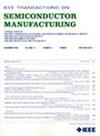利用反射阻抗无线测量薄膜生物可吸收金属的降解率
IF 2.3
3区 工程技术
Q2 ENGINEERING, ELECTRICAL & ELECTRONIC
引用次数: 1
摘要
概述了一种利用反射阻抗测定物理瞬态电子器件中生物可吸收金属的电降解率的方法。这种方法使用已知的互感器相互作用,简单的单匝盘线圈几何形状和频率测量系统来跟踪薄膜金属环的平均厚度随其退化而减少。通过光刻、热蒸发和提离制备的$\ maththrm {500~ \text {n} \text {m}}$厚锌环,在37℃去离子水中平均降解率为278 nm h−1。在37°C 1 mM盐酸中进行的实验发现了两个不同的降解期,总降解率为632 nm h - 1,与使用轮廓术测量的608 nm h - 1的降解率非常吻合。本文章由计算机程序翻译,如有差异,请以英文原文为准。
Wireless Measurement of the Degradation Rates of Thin Film Bioresorbable Metals Using Reflected Impedance
A method using reflected impedance to determine the electrical degradation rates of bioresorbable metals for physically transient electronic devices is outlined. This approach uses known mutual inductor interactions with simple single turn disk coil geometries and a frequency measurement system to track the reduction of the mean thickness of a thin film metal ring as it degrades. Experiments using
$\mathrm {500~ \text {n} \text {m} }$
thick zinc rings, fabricated by photolithography, thermal evaporation and lift-off, found a mean degradation rate of 278 nm h−1 in 37 °C de-ionised water. Experiments in 37 °C 1 mM hydrochloric acid found two distinct periods of degradation and a total degradation rate of 632 nm h−1 that closely matched the degradation rate measured using profilometry of 608 nm h−1.
求助全文
通过发布文献求助,成功后即可免费获取论文全文。
去求助
来源期刊

IEEE Transactions on Semiconductor Manufacturing
工程技术-工程:电子与电气
CiteScore
5.20
自引率
11.10%
发文量
101
审稿时长
3.3 months
期刊介绍:
The IEEE Transactions on Semiconductor Manufacturing addresses the challenging problems of manufacturing complex microelectronic components, especially very large scale integrated circuits (VLSI). Manufacturing these products requires precision micropatterning, precise control of materials properties, ultraclean work environments, and complex interactions of chemical, physical, electrical and mechanical processes.
 求助内容:
求助内容: 应助结果提醒方式:
应助结果提醒方式:


